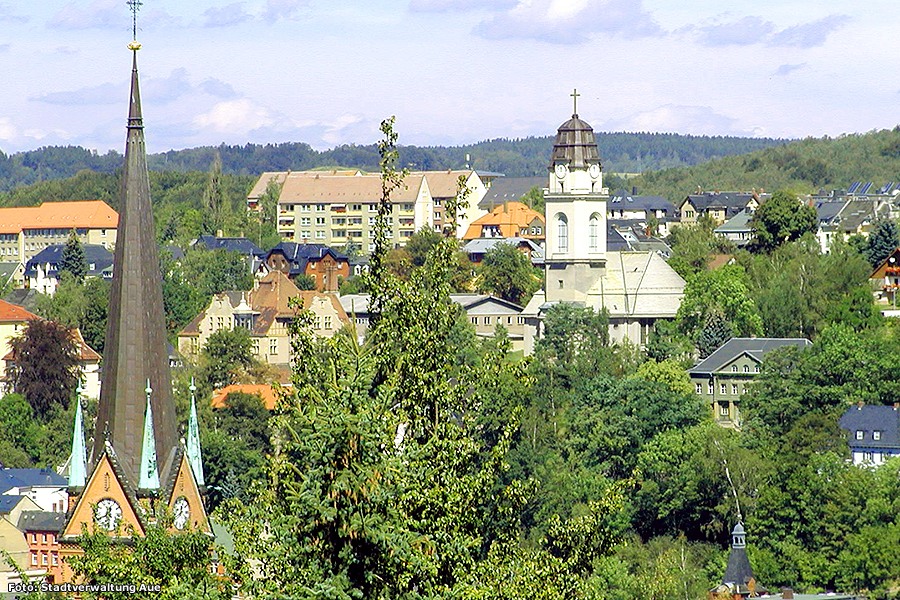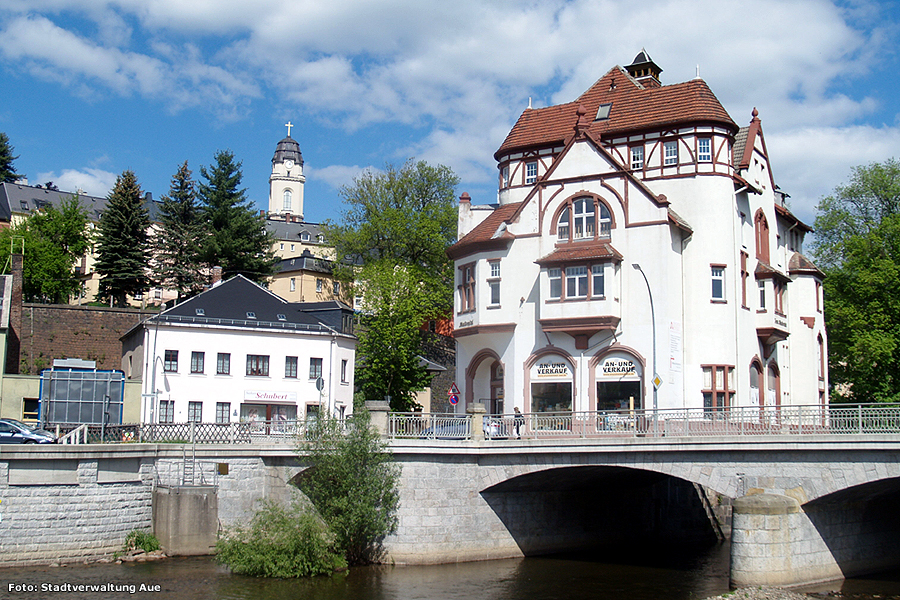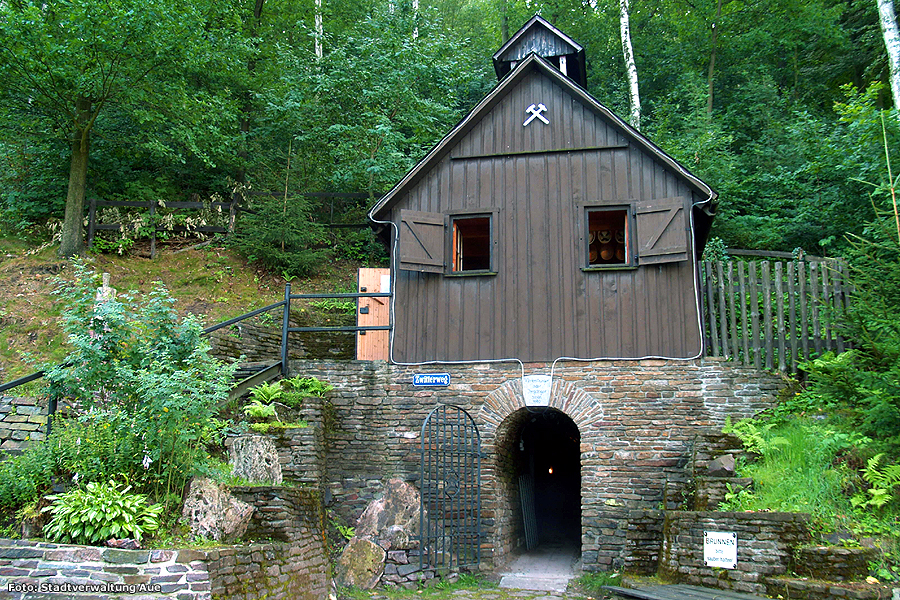
Aue
Große Kreisstadt Aue
Seit 840 Jahren ist, mit der Gründung einer von Kaiser Friedrich I. Barbarossa (Kaiser Rotbart) am 7. Mai 1173 urkundlich bestätigten kleinen Augustiner-Chorherren-Propstei, menschliches Tun im Talkessel am Zusammenfluss von Mulde und Schwarzwasser nachweisbar. Die Klosterkirche aus dem 12. Jahrhundert im Ortsteil Zelle ist gut erhalten und kann übrigens heute noch, als somit ältestes Gebäude von Aue, besichtigt werden.
Die Stadt liegt in einem weiten Tal von 330 m auf 600 m ansteigend. Die Stadtgebiete Eichert, Brünlasberg und Zelle bilden die umgebenden Berge, wobei sich dichte Wälder an die Wohngebiete anschließen.
In Aue gibt es sehr schöne, historisch und architektonisch interessante alte Gebäude. Neben der Klosterkirche aus dem 12. Jahrhundert ist der älteste Profanbau der Stadt das Herrenhaus Auerhammer. Ebenfalls ein sehr interessantes und altes Gebäude der Stadt ist der Edelhof im Ortsteil Alberoda. Hervorgegangen aus einer Wehranlage des Mittelalters, war der Edelhof ursprünglich ein um 1200 errichtetes Wallgut, ein Gutshof mit Schutz- und Wehrfunktion inmitten eines Wassergrabens.
1661 stieß man beim Bau eines Bierkellers für den Oberförster Johann Georg Rachals auf reiche Zinnvorkommen am Auer Heidelsberg. Damit begann das Auer Berggeschrey.
Bekannt wurde die Stadt auch für Produkte, die für die Herstellung von Porzellan notwendig waren. Ab 1635 produzierte das Auer Blaufarbenwerk (heute Nickelhütte), die erste große Farbenmühle Sachsens, den Farbstoff Kobaltblau aus Kobalt. Zu Beginn des 18. Jahrhunderts wurde weiße Erde (Kaolin) abgebaut. Anfangs als Perückenpuder verwendet, stellte sich bald heraus, dass dieses an Tonerde reiche Gestein aufgrund seines Reinheitsgrades ideal für die Porzellanherstellung war. Bis 1854, also ca. 150 Jahre lang, lieferte das Bergwerk „Weiße Erdenzeche St. Andreas“, dessen Huthaus bis heute erhalten blieb und zu dem ein Bergbaulehrpfad führt, als Alleinlieferant den Rohstoff für das wertvolle Meißner Porzellan.
Mit dem Abbau von Eisenerzen und zinnhaltigen Gesteinen bis ins 18. Jahrhundert entwickelte sich der Bergbau und nachfolgende Industriezweige sehr rasch. Aue erlebte einen wirtschaftlichen Aufschwung. Durch den steigenden Wohlstand durch die Industrialisierung konnten große Bürgerhäuser und Villen im damals modernen Jugendstil errichtet werden.
Weithin zu sehen ist die aus roten Backsteinen um 1900 errichtete Nicolaikirche, die im Volksmund auch „rote Kirche“ genannt wird. Eine Besonderheit ist auch die Friedenskirche, die wegen ihrem Kupferdach und der grünen Patina auch „grüne Kirche“ genannt wird. Diese Kirche gilt als eine der größten Jugendstilkirchen Sachsens. Als Jugendstilkirche reinster Bauart ist sie sogar einmalig in ganz Deutschland.
Einmalig sind auch die Flusslandschaften im Auer Stadtgebiet. Hier in Aue fließen nicht nur Mulde und Schwarzwasser zusammen, auch viele andere kleiner Bäche haben ihren Weg durch das Auer Tal gefunden. Besonders berühmt und bekannt sind die Auer Brücken. Kaum eine andere Erzgebirgsstadt hat so viele Brücken pro Quadratkilometer wie Aue, sodass man Aue auch zuweilen als die Brückenstadt bezeichnet.
Neben den vielen kleinen grünen Oasen in der Stadt, wie dem Auer Stadtgarten mit dem Carolateich oder auch dem Terrassenufer an der Mulde, gibt es auch das Naherholungsgebiet Heidelsberg mit einem sehr schönen Aussichtspunkt in rund 550 m Höhe.
Aue ist jedoch nicht nur als Brückenstadt, sondern zurecht auch als die „Sportstadt im Erzgebirge“ bekannt.
Sehenswert ist auch der Auer Tiergarten „zoo der minis“. Neben Museum, Bibliothek, Freibad, Schwimmhalle, gibt es auch eine Eislaufhalle, Kino, Bowlingbahnen und jede Menge anderer Freizeiteinrichtungen.
Große Kreisstadt Aue-Bad Schlema
Goethestr. 5
D-08280 Aue
Telefon: +49 (0)3771 / 281125
E-Mail: info@aue.de
Homepage: www.aue.de
Stadtinformation Aue-Bad Schlema
Goethestr. 5
D-08280 Aue
Telefon: +49 (0)3771 / 281125
E-Mail: stadtinformation@aue.de
Homepage: www.aue.de



